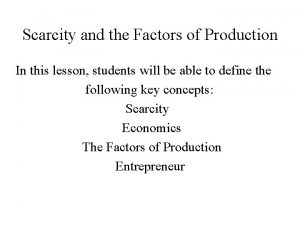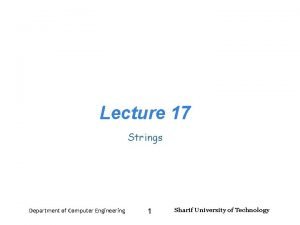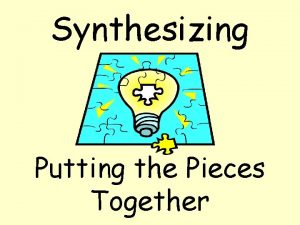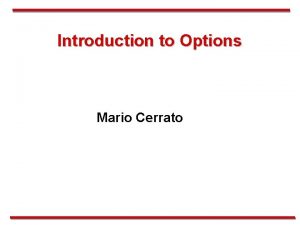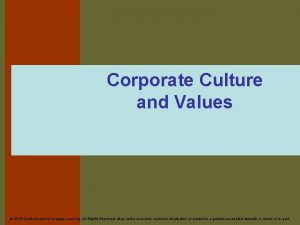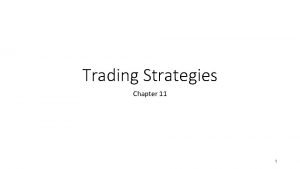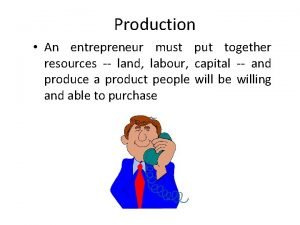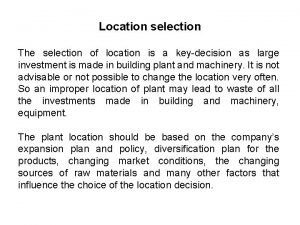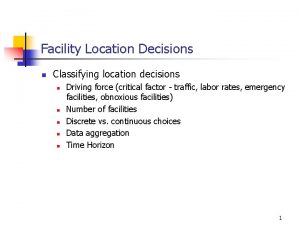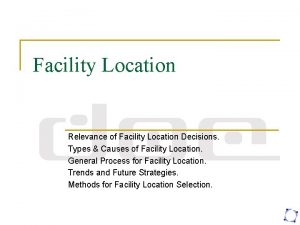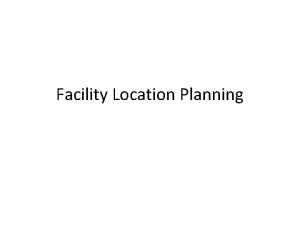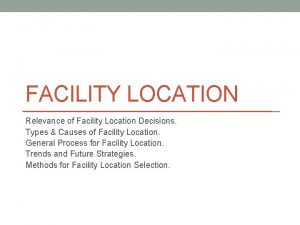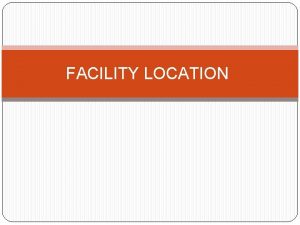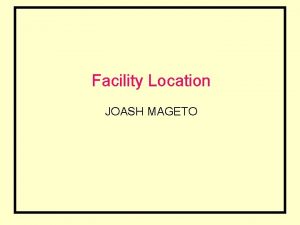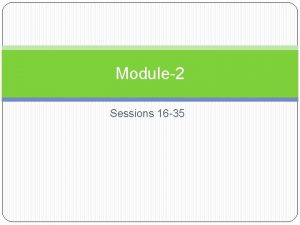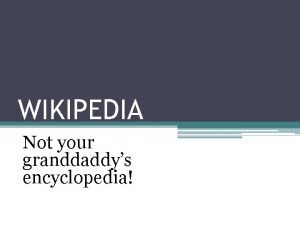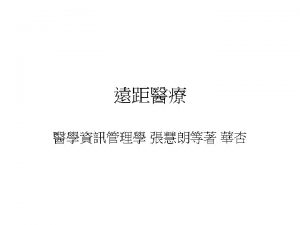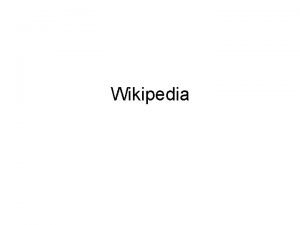Facility Location Facility Location As Wikipedia puts it


















- Slides: 18

Facility Location…


Facility Location As Wikipedia puts it, Facility Location is a branch concerned with optimal placement of facilities to minimise transportation costs while considering factors like material availability and competitors’ facilities. Key Features: • Crucial for any business unit • Irreversible decision • Various factors and theorems involved.

T I L I C A F Y When ? Establish new Plant Expansion, Diversification, Decentralisation Non- Renewal of Lease Agreement Do away with Undesirable Location Meet Socio-Economic Needs

Factors Influencing L cation… Strategic Considerations Raw Material Future Expansion Fuel, Power, Electricity Labour Availability Nearness to market Transportation Facilities Advantages and Concessions Political and Economic Conditions. Government Policy Momentum of Early Start


1. 2. Region Industry Needs Community Locality Factors Exact Site 3. Company Specific Needs Process of Selection of Location…

Theories

Traditional Approach… Locational Decisions were based on factors like personal choice, local loyalty, etc. Under the approach, the problem of location was not analysed scientifically. *Transportation, Labour mobility problems always remained.

Weber’s Deductive Theory of Location… As stated by Britannica, theory states that an industry is located where the transportation costs of raw material and final product is minimum. Raw Material Finished Goods Transportation Cost > Transportation Cost = Location of Raw Material Finished Goods Transportation Cost < Transportation Cost =Location of Finished Goods Market Other Factors: • Labour • Agglomerative: Encourage concentration • Deglomerative: Discourage concentration

Andreas Predohl’s Approach Andreas proposed that every change in location of industry is governed by change in combination of means of production. Certain added advantages may encourage change, but what all, these have not been explained by him. Sargent Florence’s Inductive Approach More than the region or area, Sargent emphasised on the working population of an area for making locational decisions. Introduced 2 concepts under the approach…

(i) Location factor: Location factor indicates the centralization or decentralisation of an industry. If… LFI > Unity = Tendency of centralization (More industries in the region than due) LFI < Unity = Decentralisation is true ( Region does not have sufficient share of Industry) *In case of unity, a state of evenness exists this indicates that there is neither centralization nor decentralization ( Industry is evenly distributed). LFI = Total Working Population of a region Total Working Population of the country x 100 ii. Coefficient of Localization: Coefficient of localization indicates the propensity of concentration of industries; the tendency of a particular industry to concentrate or disperse in a particular area. Coefficient of Localisation = % of workers in the area - % of workers in the particular industry 100

Techniques for Location Decision…

1. Ranking Method / Factor Rating Method (i) List down the factors which affect the locational decision; may vary from one unit to another. (ii) Rank the factors from most preferred to least preferred. (iii) The site which matches the preference is chosen. 1 2 Least Imp. Not very Imp. 3 4 5 Neutral Important Most Imp. 2. Equal Weights Method (i) The sites and the critical factors are listed. (ii) The sites are assigned rating against each factor. (iii) Sum of the sites is compared for final decision. Factors Site A Site B Site C F 1 1 3 2 F 2 2 3 1

3. Composite Measure Method *Quantitative + Qualitative Factors (i) List down the Quantitative factors with their costs for different sites (ii) List down the Qualitative factors with remarks (high, poor, low, excellent) for different sites. (iii) Compare the total cost from (i) and overall remarks from (ii) for final locational decision. 4. Dimensional Analysis *Follows the thought school – Some factors are non-quantifiable which can atleast be compared in terms of relative merit/demerit. (i) Assign each factor with appropriate weightage and calculate cost ratios, taking in account the weights. A 1, A 2, … = Costs associated with Site A B 1, B 2, … = Costs associated with Site B Cost Ratio: Site A = { A 1} `w 1 x { A 2 } `w 2 x… Site B B 1 B 2 (ii) If the Ration A/B > 1, Site B is better and vice- versa.

5. Load Distance Method For comparison between large number of facilities when shifting from an existing facility. Includes the following: A. Median Load Method Suppose, we want to locate a new plant that will annually receive shipments from two sources, F 1 and F 2. The plant will create finished goods that must be shipped to two warehouses, F 3 and F 4. Given these locations where should we locate the plant to minimise transportation costs for this network? *Considering the geographical area as a graph with X and Y coordinates, we find optimum X-Y coordinates for the plant that result in minimum transportation cost. (i) Find the Median Value of Loads (raw material + goods) moved. (ii) Find X-coordinate that sends or receives the median load. (iii) Find Y-coordinate that sends or receives the median load.

B. Centre of Gravity Method In this, x, y = Coordinates of existing facilities L = Loads to be transported between the existing and the new facilities Coordinates of New Plant: x 0 = x. L L y 0 = y. L L C. Break-Even Analysis (i) For every location in the list, break-even chart is created considering Fixed Costs, Variable Costs and Revenue. *The intersection point between total cost and total revenue line is marked as break even point. Area below the point represents losses; above the point represents profits. (ii) Break-Even Volume = Fixed Cost Revenue – Variable Cost *Lower the Break-Even Volume, better is the location.

ü Facility Location ü Features ü When is it Required? ü Factors Influencing Locational Decisions ü Process of Selection of Location ü Theories of Location ü Techniques of Location
 Cara penggunaan puts
Cara penggunaan puts Rima puts the tub in the sun
Rima puts the tub in the sun They say i say moves that matter in academic writing
They say i say moves that matter in academic writing Function machines maths
Function machines maths Who is a person who puts together land
Who is a person who puts together land Difference between string and array
Difference between string and array Together
Together Butterfly spread
Butterfly spread The official nordstrom organization chart puts the
The official nordstrom organization chart puts the Definition of calls and puts
Definition of calls and puts The official nordstrom organization chart puts the
The official nordstrom organization chart puts the Reverse protective put
Reverse protective put Who puts together land , labour and capital for production
Who puts together land , labour and capital for production Differentiate between gets() and puts()
Differentiate between gets() and puts() Facility location factors
Facility location factors Location decisions
Location decisions Definition of facility layout
Definition of facility layout Layout tempat usaha
Layout tempat usaha Locational break even analysis
Locational break even analysis




